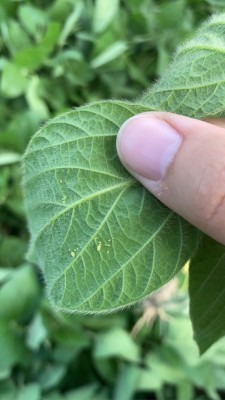Adding an Insecticide to your Soybean Herbicide Tank Mix
Katelyn Miller, Field Crops and Forage Specialist
Southwest New York Dairy, Livestock and Field Crops Program

I was recently asked; if you're going to apply herbicides to your soybeans and know that aphids are present, should you add an insecticide to the tank mix? Mike Stanyard, Field Crop Specialist with the Northwest NY Team says that there are 3 specific factors to keep in mind.
- 1. In-season stress
- 2. Natural enemy populations
- 3. Field history
In-season stressors like drought can help influence early-season spraying decisions. When aphids feed, they remove phloem from the plant which contains water. Various parts of the region have been getting rain, but dry conditions remain for many. Because water is already limited to the plant, spraying early on can help reduce plant stress.
Take note of natural enemy populations when scouting. Various insects, such as lady beetles, will help slow down populations by feeding on them. If you notice a high density of natural enemies, consider not adding insecticide to the mix. An application will kill all the unwanted insects, but also all the beneficials. If you know natural enemies are present, let them try to reduce populations naturally.
Field history can be a huge factor in making the decision to spray. Buckthorn is a woody shrub that is the overwintering host of soybean aphids. If it is present on your field edges, your field is at higher risk of infestation in season. Fields that are at high risk should consider using a pre-emergence herbicide to prevent aphid colonization. Aphids can be killed before laying eggs when there is an early frost. This can help to reduce populations for the following year. Remember that this past fall, it was mild, so be prepared for higher levels of aphid colonies in your fields this year.
These factors play into making the decision to add an insecticide to the tank mix, but It's also important to highlight scouting factors that will impact it as well. Let's review some scouting tidbits:
- Scout for aphids every week. Development is fastest when temperatures are between 70°F and mid 80°s. Under ideal conditions, there can be as many as 18 populations per year, making it important to scout frequently to keep ahead of populations.
- Ants will feed on the honeydew produced by aphids. If you see ants on plants, then you know there are aphids present.
- Remember to scout the young, fuzzy leaves on a plant. These leaves are the most susceptible to feeding. Typically, you will find them on the underside of the leaves, so make sure to check both sides of the leaf.
- The action threshold for aphids is 250 per plant. If 80% of the plants you pulled meet this threshold, then you should act. This threshold gives you approximately 7 days to treat the field before populations reach the economic threshold of 500 aphids per plant.
For more information on soybean aphids, visit https://extension.umn.edu/soybean-pest-management/scouting-soybean-aphid#whole-plant-counts-1353560.
Upcoming Events
Crops, Cows & Critters - Southwest New York Dairy, Livestock & Field Crops Newsletter Sponsorship
December 19, 2025
Our two forms of publications feature research-based and timely information from our four specialists, listed to the right, along with local event notifications and Cornell University outreach. This information is provided to participants who range from dairy, livestock, and field crops producers to agricultural suppliers and consultants.
Weekly Email Update: Shared with 625+ households who have signed up with our program.
Monthly Paper Mailer: To reach our stakeholders and farmers who lack internet access, we send out a monthly mailer where your company's logo and contact information would be featured with a mailing list of 330+ households.
If you sponsor our weekly and monthly publications you reach approximately 955 households.
Visit our website to view our newsletters!
2025 Cornell Food Beverage & Animal Feed Manufacturer Survey
December 19, 2025
Industry and Educational Advocates for New York State's Food, Beverage, and Animal Feed Manufacturing industries:
As you know, NYS has a diverse food and beverage manufacturing industry, in both the types of industries that exist and the wide distribution of firms by scale. Many manufacturing firms have strong backward linkages to agricultural production sectors in the state that support both farm-level and downstream food industry firms and consumers. In collaboration with the New York State Department of Agriculture and Markets, a team from Cornell University's Charles H. Dyson School of Applied Economics and Management has recently rolled out the 2025 New York State Food, Beverage, and Animal Feed Manufacturer Survey. The industry will benefit from an updated assessment of the industry that informs private and public investments and opportunities to support firm growth and improved profitability.
Cornell Organic Field Crops & Dairy Conference
March 6, 2026
Waterloo, NY
Farmers, researchers, educators, and agricultural service providers from across the Northeast are invited to the 2026 Cornell Organic Field Crops & Dairy Conference, held Friday, March 6, 2026, from 8:00 a.m. to 4:30 p.m. at the Lux Hotel & Conference Center in Waterloo, N.Y.
Co-hosted by New York Soil Health and Cornell CALS, the annual conference brings together leaders in organic grain, dairy, and livestock systems to share practical tools, new research, and farmer-tested strategies to support resilient and profitable organic production.
Announcements
No announcements at this time.





